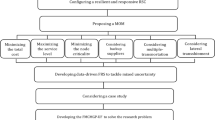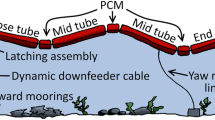Abstract
As specified from the marketing standpoint, firm hydro-electrical energy must be available on an assured basis. To achieve the firm energy yield at maximum level, simultaneous optimization of operational variables is utilized. The variables include reservoir releases over historical stream-inflow records as well as the plant factor. Here, the plant factor denotes the percentage of day for operating a peak-time power plant at full capacity. To this end, a differential evaluation (DE) algorithm equipped with an indirect constraint handling is employed, in which an adaptive penalty system imposes the desirable reliability and preserves the total energy generation. To implement the model for a real example, a reservoir dam named Karun4, in southwest of Iran, is applied. The experimental results show the firm energy produced by the current and developed method are 49.2 and 127.5 (109 watt hours), respectively. Also, the results reveal the maximum capability of generating the firm energy yield with target reliability whereas the total energy generation is preserving.










Similar content being viewed by others
References
Afshar A, Emami Skardia MJ, Masoumi F (2015) Optimizing water supply and hydropower reservoir operation rule curves: an imperialist competitive algorithm approach. Eng Optim 47(9):1208–1225
Afzali R, Mousavi S, Ghaheri A (2008) Reliability-based simulation-optimization model for multireservoir hydropower systems operations: Khersan experience. Water Res Plan Manag 134(1):24–33
Ahmadi M, Bozorg-Hadad O, Marino MA (2014) Extraction of flexible multi-objective real time reservoir operation rules. Water Resour Manag 28:131–147
Ahmadianfar I, Adib A, Salarijazi M (2015) Optimizing multireservoir operation: hybrid of bat algorithm and differential evolution. J Water Resour Plan Manag 142(2):05015010
Ahmadianfar I, Adib A, Taghian M (2016) Optimization of fuzzified hedging rules for multipurpose and multireservoir systems. J Hydrol Eng 21(4):05016003
Ahmadianfar I, Samadi-Koucheksaraee A, Bozorg-Haddad O (2017) Extracting Optimal Policies of Hydropower Multi-Reservoir Systems Utilizing Enhanced Differential Evolution Algorithm. Water Resour Manag 1–23
Ahmadi-Najl A, Haghighi A, Vali Samani HM (2016) Simultaneous optimization of operating rules and rule curves for multireservoir systems using a self-adaptive simulation-GA model. J Water Resour Plan Manag 142(10):04016041
Bozorg-Haddad O, Afshar A, Mariño MA (2008) Design-operation of multi-hydropower reservoirs: HBMO approach. Water Resour Manag 22(12):1709–1722
Bozorg-Haddad O, Karimirad I, Seifollahi-Aghmiuni S, Loáiciga HA (2014) Development and application of the bat algorithm for optimizing the operation of reservoir systems. J Water Resour Plan Manag 141(8):04014097
Chang JF, Chen L, Chang CL (2005) Optimizing reservoir operating rule curves by genetic algorithms. Hydrol Process 19:2277–2289
Chang JX, Bai T, Huang Q, Yang DW (2013) Optimization of water resource utilization by PSO-GA. Water Resour Manag 27:3525–3540
Chen L, Mcphee J, Yeh WW-G (2007) A diversified multi-objective GA for optimizing reservoir rule curves. Adv Water Resour 30:1082–1093
Cheng C, Wang W, Xu D (2008) Optimizing hydropower reservoir operation using hybrid genetic algorithm and chaos. Water Resour Manag 22(7):895–909
Davidsen C, Pereira-Cardenal S, Liu S, Mo X, Rosbjerg D, Bauer-Gottwein P (2015) Using stochastic dynamic programming to support water resource Management in the Ziya River Basin, China. Water Res Plann Manag 141(7):04014086
Erlon C, Edson L (2005) Solving the unit commitment problem of hydropower plants via Lagrangian relaxation and sequential quadratic programming. Comput Appl Math 24(3):317–341
Eum H, Kim Y, Palmer R (2011) Optimal drought management using sampling stochastic dynamic programming with a hedging rule. Water Res Plann Manag 137(1):113–122
Fallah-Mehdipour E, Bozorg-Hadad O, Marino MA (2011) MOPSO algorithm and its application in multipurpose multi-reservoir operation. Hydro Inform 13:4.794–4.811
Guo X, Hu T, Wu C, Zhang T, Lv Y (2013) Multi-objective optimization of the proposed multi-reservoir operating policy using improved NSPSO. Water Resour Manag 27:2137–2153
Heidari M, Chow VT, Kokotovic PV, Meredith DD (1971) Discrete differential dynamic programming approach to water resource system optimization. Water Resour Res 7(2):273–282
Hidalgo I, Correia P, Arnold F, Estrocio J, de Barros R, Fernandes J, Yeh WW-G (2015) Hybrid model for short-term scheduling of hydropower systems. Water Res Plann Manag 141(3):04014062
Jalali MR, Afshar A, Marino MA (2007) Multi-Colony ant algorithm for continuous multi-reservoir operation optimization problem. Water Resour Manag 21:9.1429–9.1447
Ji C, Jiang Z, Sun P, Zhang Y, Wang L (2015) Research and application of multidimensional dynamic programming in Cascade reservoir based on multilayer nested structure. Water Res Plann Manag 141(7):04014090
Jothiprakash V, Arunkumar R (2013) Optimization of hydropower reservoir using evolutionary algorithms coupled with chaos. Water Resour Manag 27(7):1963–1979
Karamouz M, Houck MH (1987) Comparison of stochastic and deterministic dynamic programming for reservoir operation rule generation. Water Resour Bull 23(1):1–9
Kjeldsen TR, Rosbjerg, D (2004) Choice of reliability, resilience and vulnerability estimators for risk assessments of water resources systems/Choix d’estimateurs de fiabilité, de résilience et de vulnérabilité pour les analyses de risque de systèmes de ressources en eau. Hydrol Sci J 49(5)
Labadie JW (2004) Optimal operation of multi-reservoir systems: state-of-the-art review. Water Res Plan Manag 130(2):93–111
Louati MH, Benabdallah S, Lebdi F, Milutin D (2011) Application of a genetic algorithm for the optimization of a complex reservoir system in Tunisia. Water Resour Manag 25(10):2387–2404
Madadgar S, Afshar A (2009) An improved continuous ant algorithm for optimization of water resources problems. Water Resour Manag 23:2119–2139
Moeini R, Afshar A, Afshar MH (2011) Fuzzy rule-based model for hydropower reservoir operation. Elec Power Energ Syst 33:171–178
Mousavi SJ, Shourian M (2010) Capacity optimization of hydropower storage projects using particle swarm optimization algorithm. J Hydroinf 12(3):275–291
Murray DM, Yakowitz S (1979) Constrained differential dynamic programming and its application to multi-reservoir control. Water Resour Res 15(5):1017–1027
Needham J, Watkins D, Lund J, Nanda K (2000) Linear programming for flood control in the Iowa and Des Moines River. Water Res Plann Manag 126(3):118–127
Oliveira R, Loucks D (1997) Operating rules for multi-reservoir systems. Water Resour Res 33(4):839–852
Ostadrahimi L, Marino MA, Afshar A (2012) Multi-reservoir operation rule: multi- swarm PSO based optimization approach. Water Resour Manag 26:407–427
Randall D, Houck MH, Wright JR (1990) Drought management of existing water supply system. J Water Resour Plan Manag 116(1):1–20
Regulwar DG, Choudhari SA, Anand Raj P (2010) Differential evolution algorithm with application to optimal operation of multipurpose reservoir. Comput Civil Eng 2(6):560–568
Revelle C, Jores E, Kirby W (1969) The linear decision rule in reservoir management and design. 1: development of the stochastic model. Water Resour Res 5(4):767–777
Rodrigues D, Pereira LAM, Nakamura RYM, Costa KAP, Yang X-S, Souza AN, Papa JP (2014) A wrapper approach for feature selection and optimum-path Forest based on bat algorithm. Expert Syst Appl 41(5):2250–2258
Rosenthal RE (1981) A nonlinear network algorithm for maximization of benefits in a hydroelectric power system. Oper Res 29(4):763–786
Schardong A, Simonovic S, Vasan A (2013) Multiobjective evolutionary approach to optimal reservoir operation. Comput Civil Eng 27(2):139–147
Simonovic SP, Marino MA (1980) Reliability programming in reservoir management, 1, single multiple reservoir. Water Resour Res 16(5):844–848
Storn R, Price K (1995) Differential Evolution a Simple and Efficient Adaptive Scheme for Global Optimization over Continuous Spaces. Technical Report, International Computer Science Institute, Berkley
Taghian M, Rosbjerg D, Haghighi A, Madsen H (2014) Optimization of conventional rule curves coupled with hedging rules for reservoir operation. Water Res Plan Manag 140(5):693–698
Tayebiyan A, Mohammed Ali TA, Ghazali AH, Malek MA (2016) Optimization of exclusive release policies for hydropower reservoir operation by using genetic algorithm. Water Resour Manag 30(3):1203–1216
Vasan A, Raju KS (2007) Application of differential evolution for irrigation planning: an Indian case study. Water Resour Manag 21(8):1393–1407
Wang J, Zhang Y (2012) Short-term optimal operation of hydropower reservoirs with unit commitment and navigation. Water Res Plan Manag 138(1):3–12
Wardlaw R, Sharif M (1999) Evaluation of genetic algorithms for optimal reservoir system operation. Water Res Plan Manag 125(1):25–33
Wurbs RA (1993) Reservoir-system simulation and optimization models. Water Res Plan Manag 119(4):455–472
Yang XS, He X (2013) Bat algorithm: literature review and applications. Bio-Inspired Comput 5(3):141–149
Yeh WW-G (1985) Reservoir management and operation models: a state-of-the-art-review. Water Resour Res 21(12):1797–1818
Yoo JH (2009) Maximization of hydropower generation through the application of a linear programming model. J Hydrol 376(1–2):182–187
Zhao T, Cai X, Lei X, Wang H (2012) Improved dynamic programming for reservoir operation optimization with a concave objective function. Water Res Plan Manag 138(6):590–596
Acknowledgments
This research is supported by the Khuzestan Water and Power Authority, Ahvaz, Iran. The authors are grateful to the staff and director of practical research department.
Author information
Authors and Affiliations
Corresponding author
Rights and permissions
About this article
Cite this article
Taghian, M., Ahmadianfar, I. Maximizing the Firm Energy Yield Preserving Total Energy Generation Via an Optimal Reservoir Operation. Water Resour Manage 32, 141–154 (2018). https://doi.org/10.1007/s11269-017-1800-9
Received:
Accepted:
Published:
Issue Date:
DOI: https://doi.org/10.1007/s11269-017-1800-9




